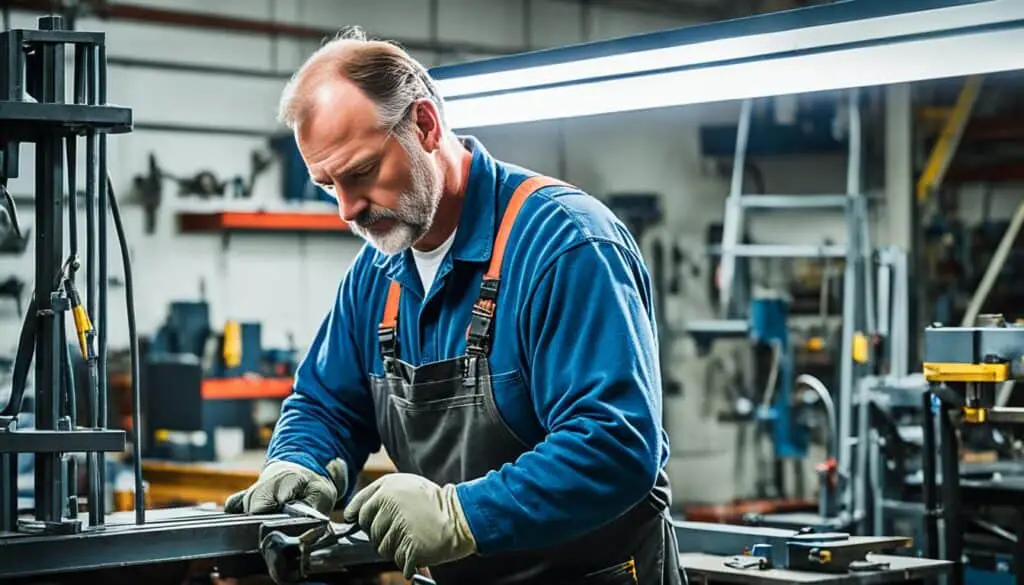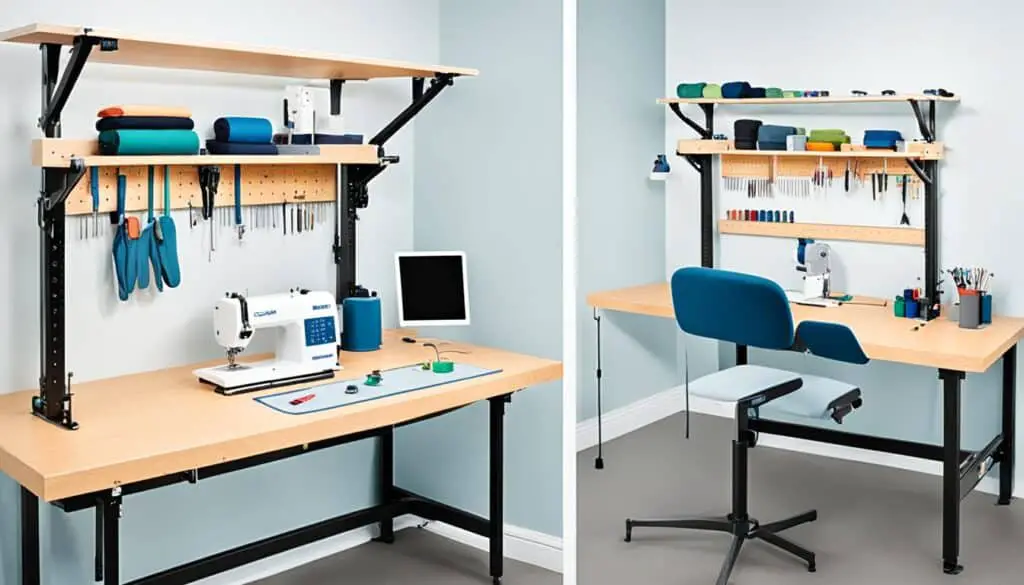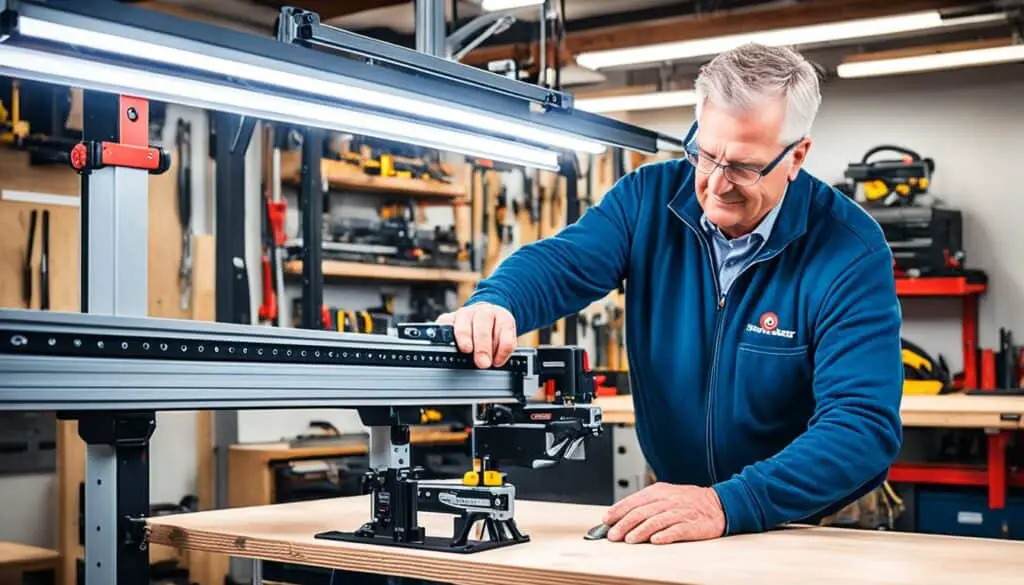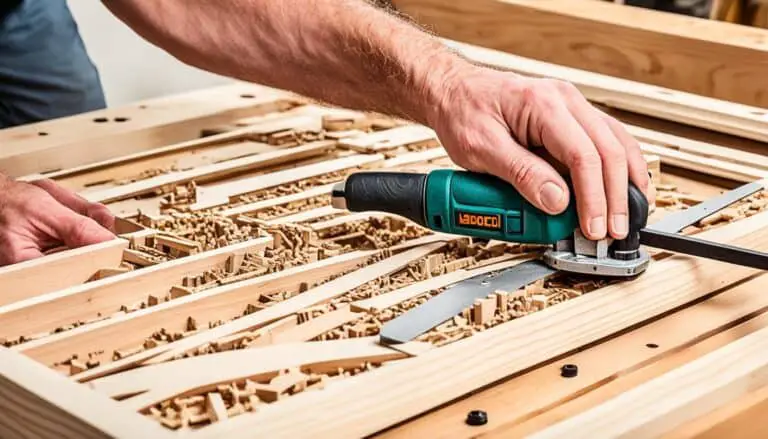Choosing the right workbench height is crucial for ensuring comfort, productivity, and overall well-being in your work environment. Whether you’re a woodworker, metalworker, electronics enthusiast, or hobbyist, finding the optimal workbench height can make a significant difference in your work experience.
So, how do you determine the correct workbench height for your specific needs? In this guide, we will explore the factors to consider when choosing a workbench height and provide recommendations based on industry standards and ergonomic principles.
Key Takeaways:
- Choosing the right workbench height can improve comfort and efficiency in your work.
- Factors such as body height, type of work, and tools used should be considered when determining the optimal workbench height.
- Woodworking, metalworking, electronics, and sewing tasks may require different workbench height ranges.
- Adjustable workbenches offer flexibility and customization options for different users and tasks.
- Take the time to find the most suitable workbench height for your individual needs to enhance your work experience.
Factors to Consider When Choosing a Workbench Height
When it comes to selecting the right workbench height, there are several factors you need to consider. By taking these factors into account, you can ensure that your workbench promotes comfort, productivity, and overall well-being in your work environment.
- Body Height: Your personal height plays a crucial role in determining the appropriate workbench height. A workbench that is too low can lead to hunching over and strain on your back, while a workbench that is too high can cause discomfort and shoulder tension. It’s essential to find a workbench height that aligns with your body height, allowing for a neutral and relaxed posture.
- Type of Work: The nature of your work is another critical aspect to consider. Different tasks require different workbench heights. For example, a higher workbench may be more suitable for tasks that involve standing and fine precision work, such as electronics assembly. On the other hand, a lower workbench may be preferable for tasks that involve sitting and focused handwork, such as sewing.
- Tools and Equipment: The tools and equipment you use also impact the optimal workbench height. Consider the range of motion required for your tools and ensure that your workbench height allows for comfortable handling and manipulation of your tools. This will help prevent strain and fatigue during prolonged work sessions.
- Posture and Comfort: Comfort should be a top priority when selecting a workbench height. Your workbench should encourage proper posture, with your arms resting comfortably on the work surface and your wrists in a neutral position. Pay attention to any discomfort or strain you feel in your neck, shoulders, or arms while working, as this can indicate an incorrect workbench height.
By carefully considering these factors and finding a workbench height that meets your specific needs, you can create an ergonomic and efficient workspace that promotes productivity and reduces the risk of work-related injuries.
“The right workbench height promotes comfort, productivity, and overall well-being in your work environment.”
Recommended Workbench Height for Woodworking
When it comes to woodworking, having the right workbench height is crucial for comfort and precision. Whether you prefer to work while standing or sitting, finding the optimal workbench height can significantly enhance your woodworking experience. To help you determine the ideal height for your woodworking workbench, we have gathered specific height ranges based on factual data from reputable sources.
Recommended Workbench Height for Standing Woodworking
If you prefer to work while standing at your woodworking bench, the recommended height range is typically between 36 to 39 inches (91 to 99 cm). This range allows for easy manipulation of tools and materials, reducing strain on your back and shoulders during extended working hours. Adjusting the height within this range allows for a comfortable working posture and promotes better ergonomics, leading to improved productivity and reduced fatigue.
Recommended Workbench Height for Sitting Woodworking
For those who prefer to work while sitting at their woodworking bench, the recommended height range is typically between 24 to 27 inches (61 to 69 cm). This range allows for proper alignment of the work surface with your seated position, enabling you to work with precision and comfort. Working at a lower height reduces the strain on your back and allows for better control over your tools, resulting in refined woodworking craftsmanship.
| Working Position | Recommended Height Range |
|---|---|
| Standing | 36 to 39 inches (91 to 99 cm) |
| Sitting | 24 to 27 inches (61 to 69 cm) |
Take note that these height ranges are general guidelines, and it is essential to consider your own body height and personal preferences when determining the optimal workbench height for your woodworking tasks. Additionally, consider the type of projects you frequently work on and the tools you use to ensure your workbench height accommodates your specific needs.
Having a workbench at the appropriate height not only enhances your woodworking experience but also helps prevent long-term strain or injuries. By aligning your work surface with your body, you can maintain a comfortable and ergonomic posture, allowing you to focus on honing your woodworking skills and achieving excellent results.
Recommended Workbench Height for Metalworking
Metalworking tasks often involve the use of heavy machinery and require different workbench heights to ensure stability and easy manipulation of tools and equipment. When it comes to metalworking, finding the optimal workbench height is crucial for enhancing productivity and reducing the risk of injuries.
Standing workbenches for metalworking should be set at a height that allows you to work comfortably without straining your back or arms. The recommended range for standing workbenches in metalworking is 38 to 42 inches. This height range ensures that you maintain a proper posture while working and have easy access to the tools and materials you need.
Sitting workbenches for metalworking are commonly used when performing tasks that require precision and detailed work. The recommended height range for sitting workbenches in metalworking is 22 to 28 inches. This lower height enables you to have greater control over your work and reduces the risk of fatigue during long hours of metalworking.
To further illustrate the recommended workbench heights for metalworking, consider the following table:
| Workbench Type | Recommended Height Range (inches) |
|---|---|
| Standing Workbench | 38 – 42 |
| Sitting Workbench | 22 – 28 |
In addition to these recommended heights, it’s important to personalize your workbench height based on your individual needs and preferences. Factors such as your height, the type of metalworking tasks you perform, and your comfort level should be taken into account when adjusting your workbench height. Experimenting with different heights and observing how it affects your workflow and posture can help you determine the optimal workbench height for your metalworking needs.
Remember, having the proper workbench height for metalworking not only enhances your productivity but also plays a crucial role in maintaining good posture and preventing work-related injuries. Adjusting your workbench height to suit your specific metalworking needs ensures a safer and more comfortable working environment.

Takeaway:
When it comes to metalworking, choosing the right workbench height is essential for comfort, safety, and efficient work. Standing workbenches in metalworking should be set between 38 to 42 inches, while sitting workbenches are recommended to be between 22 to 28 inches. Personalizing your workbench height based on your individual needs and preferences is key to achieving optimal results.
Recommended Workbench Height for Electronics
When it comes to working with electronics, having the right workbench height is crucial for precision and convenience. Whether you’re soldering components or assembling circuit boards, finding the optimal workbench height can greatly enhance your productivity and reduce the risk of strain or injury.
For electronics workbenches, there are recommended height ranges for both standing and sitting positions that you should consider. These ranges are based on comprehensive research and expert recommendations from trusted sources in the field.
Recommended Workbench Height
For standing workbenches in electronics, the optimal height range is typically between 36 to 42 inches (91 to 107 centimeters). This range allows you to work comfortably while maintaining good posture and reaching your tools and equipment with ease.
If you prefer working while seated, the recommended height range for sitting workbenches in electronics is between 25 to 31 inches (64 to 79 centimeters). This range ensures proper ergonomics, allowing you to sit comfortably and work efficiently for extended periods.
It’s important to note that these height ranges serve as general guidelines. Factors such as your own height, arm length, and personal preference may influence your choice of workbench height. Adjustments may be necessary to find the perfect fit for your individual needs.
Recommended Workbench Height for Electronics
| Workbench Position | Height Range |
|---|---|
| Standing | 36 to 42 inches (91 to 107 centimeters) |
| Sitting | 25 to 31 inches (64 to 79 centimeters) |
Remember, the goal is to create a comfortable and ergonomic workspace that allows you to work efficiently without straining your body. By following these recommended height ranges, you can optimize your electronics workbench for maximum performance and comfort.
Whether you’re a hobbyist or a professional, investing in the right workbench height for your electronics work can significantly enhance your work experience. Now that you have the insights on the optimal workbench height for electronics, you can set up your workspace to suit your needs and achieve optimal results.
Recommended Workbench Height for Sewing
Sewing tasks require precision and attention to detail, making it crucial to have a workbench height that promotes comfort and proper alignment. The optimal workbench height for sewing depends on various factors, including your body height and the type of sewing you engage in. By selecting the right workbench height, you can enhance your sewing experience and improve the quality of your work.
When determining the workbench height for sewing, consider the following:
- Your body height: A workbench that is too high or too low can strain your back, neck, and shoulders. Finding the right height based on your body measurements is essential for maintaining a healthy posture while sewing.
- The type of sewing: Different types of sewing, such as hand sewing, machine sewing, or quilting, may require different workbench heights. For instance, machine sewing often involves sitting, while quilting may require a standing workbench.
To help you find the optimal workbench height for sewing, here are the recommended height ranges for both standing and sitting workbenches:
| Task | Standing Workbench Height (inches) | Sitting Workbench Height (inches) |
|---|---|---|
| Hand Sewing | 36 – 38 | 26 – 28 |
| Machine Sewing | 28 – 30 | 19 – 21 |
| Quilting | 38 – 40 | N/A |
These height ranges are approximate and may vary depending on your individual preferences and body measurements. It’s essential to experiment with different workbench heights and adjust accordingly to find what works best for you.
Remember to prioritize your comfort and maintain proper posture while sewing. Pay attention to any signs of discomfort or strain, and make adjustments to your workbench height as needed. By doing so, you can create an optimal sewing environment that enhances your productivity and enjoyment of the craft.

Adjusting Workbench Height
Workbenches should be adjustable in height to accommodate different users and tasks. Whether you need a higher work surface for standing tasks or a lower one for seated work, the ability to customize the height of your workbench is essential for optimal comfort and productivity. In this section, we will explore the different methods of adjusting workbench height and provide practical guidance on how to achieve the perfect work surface alignment.
Manual Adjustment
One common method of adjusting workbench height is through manual adjustment. This allows you to modify the height of your workbench to suit your specific needs. One way to achieve manual adjustment is by using adjustable legs or feet. These can be extended or retracted to raise or lower the workbench, providing a customizable working surface. Some workbenches feature a crank mechanism that allows for quick and easy height adjustments. By turning the crank, you can raise or lower the workbench to your desired height, ensuring ergonomic comfort.
Electric Adjustment
For a more convenient and effortless way to adjust workbench height, electric adjustment mechanisms are available. These motorized systems allow you to raise or lower the workbench with the push of a button, providing precise customization to meet your needs. Electric adjustment mechanisms are especially beneficial for individuals who require frequent height changes or who have limited physical abilities. With the ability to fine-tune the workbench height, you can create a comfortable and ergonomic workspace that enhances your productivity.
Adjusting workbench height is a crucial aspect of creating a workspace that promotes productivity and minimizes discomfort. Whether you prefer manual adjustment or the convenience of electric adjustment, having a workbench that can be customized to your specific needs is essential. By optimizing the height of your workbench, you can achieve better posture, reduce strain on your body, and work more efficiently. Take the time to adjust your workbench height and experience the difference it can make in your daily tasks.

How Tall Should a Workbench Be for You?
Determining the best workbench height for you is crucial to achieve optimal comfort and productivity. Several factors should be considered in finding the right workbench height, including your body height, the type of work you do, and the tools and equipment you use.
First, let’s start with your body height. Your workbench should be set at a height that allows you to maintain proper posture and avoid discomfort or strain. Here’s a general guideline:
“For individuals of average height (around 5’8″ to 5’10”), a workbench height between 34 to 36 inches is often suitable for most tasks.”
However, if you are significantly taller or shorter than average, it’s important to adjust the workbench height accordingly to ensure proper alignment and reduce the risk of musculoskeletal issues.
Next, consider the type of work you do. Different tasks require varying workbench heights for optimal performance. For example:
- Woodworking tasks typically benefit from a slightly higher workbench height to accommodate sawing, planing, and other woodworking techniques. A standing workbench height between 38 to 40 inches may be suitable for woodworking.
- Metalworking tasks often involve heavy machinery and require a stable workbench. A standing workbench height between 36 to 38 inches is generally recommended for metalworking.
- Electronics work requires precision and intricate movements. A sitting workbench height between 30 to 32 inches is often preferred for electronics assembly.
- Sewing tasks necessitate a workbench height that allows for comfortable fabric manipulation. A sitting workbench height between 28 to 30 inches is commonly selected for sewing workbenches.
Finally, take into account the tools and equipment you use. The size and design of your tools may influence the ideal workbench height. If you regularly use large, bulky tools, you may prefer a slightly lower workbench height to facilitate handling and maneuverability.
By considering your body height, the nature of your work, and the tools you use, you can determine the optimum workbench height that will enhance your comfort and productivity. Don’t forget to make adjustments as needed to ensure a comfortable and ergonomic work environment.
In the next section, we will explore the different methods of adjusting workbench height, including manual and electric options, to accommodate various users and tasks.
Conclusion
Choosing the optimal workbench height is crucial for both comfort and efficiency in various work environments. Throughout this guide, we have discussed the factors to consider when determining the correct workbench height and provided specific recommendations for different types of work tasks.
By considering factors such as body height, the type of work being performed, tools and equipment used, and posture, you can ensure that your workbench is ergonomically suited to your needs. Proper ergonomics can help prevent discomfort, fatigue, and even long-term health issues caused by prolonged incorrect posture.
Whether you’re woodworking, metalworking, working with electronics, or sewing, adjusting your workbench to the appropriate height can significantly enhance your productivity and overall well-being. Don’t overlook the importance of an adjustable workbench that can be customized to fit your individual requirements.
In conclusion, finding the optimal workbench height is a key aspect of creating a functional workspace. Consider the guidelines provided in this guide and make use of reliable sources for additional information. Prioritizing your ergonomic well-being will not only improve your work experience but also contribute to your long-term health and productivity.
FAQ
What factors should I consider when choosing a workbench height?
When choosing a workbench height, it is important to consider factors such as body height, the type of work being performed, tools and equipment used, and posture and comfort.
What is the recommended workbench height for woodworking?
The recommended workbench height for woodworking tasks varies depending on whether the work is performed while standing or sitting. For standing workbenches, the height range is typically between 36 to 39 inches. For sitting workbenches, the height range is typically between 27 to 30 inches.
What is the recommended workbench height for metalworking?
Metalworking tasks often involve the use of heavy machinery and require different workbench heights to ensure stability and easy manipulation of tools and equipment. For standing workbenches, the height range is typically between 35 to 38 inches. For sitting workbenches, the height range is typically between 25 to 28 inches.
What is the recommended workbench height for electronics work?
Electronics work requires precise movements and easy access to tools and components. For standing workbenches, the height range is typically between 32 to 35 inches. For sitting workbenches, the height range is typically between 22 to 25 inches.
What is the recommended workbench height for sewing?
Sewing tasks involve various manipulations of fabric and require a specific workbench height to ensure comfort and proper alignment. For standing workbenches, the height range is typically between 28 to 31 inches. For sitting workbenches, the height range is typically between 24 to 27 inches.
Can workbenches be adjustable in height?
Yes, workbenches can be adjustable in height to accommodate different users and tasks. They can be manually adjusted or electrically adjusted based on individual preferences and needs.
How can I determine the best workbench height for me?
Determining the best workbench height for an individual involves considering factors such as body height, type of work, and tools and equipment used. It is recommended to measure the height from the floor to your elbow and adjust the workbench height to that measurement for optimal comfort and efficiency.












